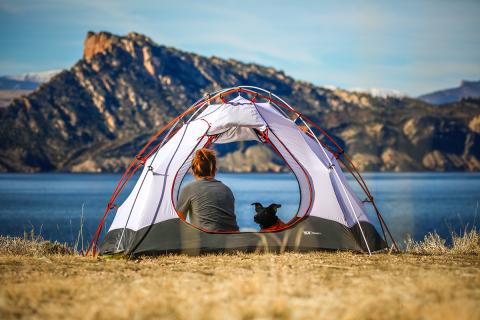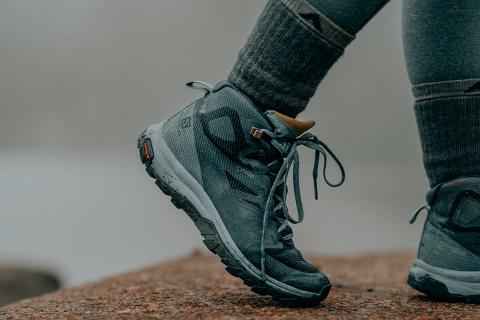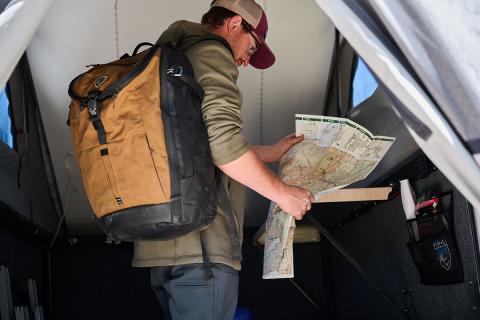
Keep Your Gear Like New: Cleaning, Repair, and Storage Tips
Table of Contents [Show]
You’ve just experienced a few days or more exploring the great outdoors. We get it – the last thing you want to do when you get home is tackling the task of cleaning your gear. But, as any outdoor enthusiast knows, gear is pricey stuff—and that’s if you buy it once. So putting in just a little bit of time and effort into keeping your gear cleaned, repaired, and stored properly has a big impact on its lifespan and performance.
Many wear-and-tear issues can be eliminated with proper maintenance and storage, and most damage can be addressed without replacing the item. By getting into a “Repair > Replace” mindset, you’ll save money and act more environmentally friendly. Your used gear is already part of the waste cycle, and by repairing instead of replacing it, you’re reducing the carbon output of the manufacturing process.
Fortunately, you don’t have to be an expert to keep your gear in good working order; it just takes discipline and know-how. Here are some insider tips on how to clean, repair and store your outdoor gear so you can enjoy it for many adventures to come.

Tents
Cleaning: Before breaking down your tent, pick the whole thing up and shake it out, removing potentially abrasive debris. For a more thorough cleaning at home, set up the tent and wipe down the fly and body with a diluted mixture of hand soap and warm water.
Repairs: Silnet is a great product created specifically for treated nylon products like tents. It works like Super Glue and can be used for seam reinforcement or to fix pinhole tears. Small rips in the mesh can be repaired with mesh repair patches, which have an adhesive that allows you to fix the tear without a sewing kit. Clean fabric with rubbing alcohol beforehand, allowing sufficient drying time, to help the patches stay in place.
Storage: The first rule of thumb: Always store your tent flat and clean! Resist the urge to crumple it into the bottom of a stuff sack. Yes, it’s so easy to let camping gear get strewn everywhere after a trip, but take the time to lay your tent out and fold it along the seams, where it’s least likely to crack, and you’ll improve its lifecycle.
Can You Wash a Tent in a Front-Loading Washing Machine?
No, you shouldn’t try to wash your tent in the washing machine, it may rip your tent and cause unnecessary damage. It’s best to wash your tent by hand! Never use detergent or put the tent through any washing machine—it could also damage any protective coatings.

Down Jackets and Sleeping Bags
Cleaning: Experts recommend washing down items like the Spyfire Jacket at least once a season, which helps maintain the loft and warmth-to-weight ratio.
- Wash. Use a front-loading machine (the agitators in top-loading machines can damage the fill) and wash on a gentle, cold cycle with a small amount of down-specific wash. It helps to add a few other items to the machine to balance the spinning.
- Dry. Tumble dry on a gentle setting, checking often—if the dryer gets too hot, the face fabric can melt. When the item is nearly dry, add a few tennis balls to the dryer to break up any clumps of fill.
Repairs: A small tear in the face fabric shouldn’t be the end of a jacket or sleeping bag. Take a glance around any group of outdoorsy folks, and you’ll see gear decorated with patches of duct tape, which is all it takes to fix a small tear.
Storage: Always stash your down items at their highest loft possible, which means don’t compress them into tight bags for long-term storage. Leaving down compressed can degrade the loft and create weakness in material treatment. Upon returning from your trip, remove the sleeping bag or jacket from its stuff sack and shake it out. Your sleeping bag likely came with a large mesh or lightweight bag—perfect for storage. If you don’t have the original, you can find one online or at a local gear shop.

Pants
Cleaning: Washing instructions vary depending on the pants. Most outdoor pants like the Renegade™ Pant can be cleaned in the washing machine with either cool or warm water – try to avoid using hot water because this will likely fade colors over time. The same advice goes for using any harsh chemicals, like bleach, just don’t use it. Instead, use a gentle detergent or one specifically designed for the material of your pants.
Repairs: For small tears and holes, you may need a needle and thread, a patch, or fabric glue. For larger damage, you may need a sewing machine or professional tailoring services. To repair a broken zipper pull, you can use pliers to reattach it or replace it with a new one. To fix a stuck zipper, you can use a pencil or paper clip to gently push the zipper teeth back into place. To repair a separated zipper track, you can use a needle and thread to sew it back together.
Storage: Choose the right location for storage. Pants should be stored in a cool, dry place that is free from extreme temperatures and moisture. A closet or storage room is often a good choice, but you can also use a shed or garage if they are well-ventilated and dry. Avoid exposing the pants to direct sunlight or heat sources. These can cause the fabric to fade, shrink, or become stiff, reducing the pants' performance and lifespan. Use a hanger to store the pants. This can help prevent wrinkles and creases, and allow the pants to air out and maintain their shape. Avoid using wire hangers, as these can cause the fabric to stretch and sag.
How to Wash Technical Hiking Pants
Technical hiking pants are typically made of synthetic fabrics that may require special care to maintain their performance and durability. For example, regular laundry detergents can break down the fabric and cause it to lose its color or performance, so it may be necessary to use a specialized detergent when washing technical pants. In addition, technical hiking pants are typically treated with water-resistant products or other protective coatings, which can be damaged or removed by excessive heat or harsh chemicals.
It is important to follow the care instructions on the label when washing technical hiking pants to ensure they are properly cleaned and maintained. As general advice follow these tips when washing technical hiking pants:
- Avoid using bleach, regular laundry detergent, and hot water, and avoid any exposure to excessive heat.
- Always wash on a gentle cycle with either cool or slightly warm water.
- Look for a detergent that is specifically designed for use on outdoor gear, or use a gentle, all-purpose detergent.
- If the pants have removable pads or other detachable parts, remove them before washing. This can prevent damage to the parts and allow for more thorough cleaning of the pants.

Rain Gear
Cleaning: Rain gear like the Stretch Voyagr™ Jacket needs to be washed a few times per season, especially gear with an ePTFE membrane. ePTFE is an expanded plastic membrane with 9 billion pores per square inch. This technology creates a waterproof, breathable layer that prevents water drops from saturating, but allows the vapor to leave. ePTFE—utilized in garments listing Gore-Tex or eVent—is oleophobic, which means oils from your skin can clog the microscopic pores and cause the jacket to lose breathability.
No matter what the waterproofing, rain gear has a Durable Water Resistant (DWR) treatment on the face fabric, and residue from campfires and other contaminants can reduce the effectiveness of the coating. Washing garments with mild powder detergent or a tech wash will revive them.
Repairs: Check the fabric and along the seams for rips, tears, or seam failure. If you find a seam failure, a product like Seam Grip can come to the rescue. For small tears on the face fabric, a patch kit from the manufacturer or your local gear shop will do the trick. To revive an older garment, give it a DWR treatment and it’ll feel nearly good as new.
Storage: Store your rain gear out of direct sunlight, preferably hanging up and not crumpled. This will help prevent the laminates from cracking. And it should go without saying, but never shove the jacket into the closet when it’s still wet, which breeds mildew and other funky, damaging stuff.
How to Wash Waterproof Jackets
- Check the care instructions on the label to see if it is safe to wash the jacket in a washing machine. Some waterproof jackets may need to be hand-washed or professionally cleaned to maintain their performance.
- Use a specialized detergent for waterproof fabrics. Regular laundry detergents can break down the waterproof coating on the jacket, reducing its ability to repel water. Look for a detergent that is specifically designed for use on waterproof fabrics, such as those used in outdoor gear.
- Avoid using excessive heat when drying the jacket. Heat can cause the waterproof coating to become brittle and crack, reducing its effectiveness. Instead, hang the jacket up to air dry, or use a low heat setting on your dryer.
- If the jacket has a removable hood or other detachable parts, remove them before washing. This can prevent damage to the parts and allow for more thorough cleaning of the jacket.
- If the jacket is heavily soiled or has stubborn stains, you may need to spot-clean it before washing. Mix a solution of warm water and mild detergent, and use a soft brush or cloth to gently scrub the stained areas. Rinse the jacket with clean water, and then proceed with washing it according to the care instructions on the label.

Hiking Boots
Cleaning: While much of the backpacking world is migrating to synthetic trail shoes, leather hiking boots still hold a corner of the market. Clean your boots at home by scrubbing dirt off with mild soap and an old toothbrush, and treat them with a leather cleaner every few months. Never put boots through the washing machine.
Repairs: If your waterproof boots are wetting out, apply a waterproofing agent, following the package instructions. If the outsole is beginning to separate, it might be a job for your local repair shop, or you can try to DIY by applying an adhesive like Shoe Goo.
Storage: When it’s time to put away the boots for the season, clean them thoroughly before storing them, removing all caked-on dirt. If the midsoles are removable, pull them out to allow ventilation.
How to Wash Leather Boots
- Use a soft brush or cloth to remove any surface dirt or debris from the boots. Be gentle and avoid using excessive force, as this can damage the leather or cause the stitching to come loose.
- Mix a solution of warm water and mild detergent in a bucket or basin. Dip a soft brush or cloth into the solution, and use it to scrub the boots, paying particular attention to any heavily soiled or stained areas.
- Rinse the boots with clean water to remove any remaining dirt or detergent. Be sure to rinse them thoroughly, as any remaining detergent can damage the leather or cause the boots to become stiff and uncomfortable.
- Allow the boots to air dry. Avoid exposing the boots to direct heat or sunlight, as this can cause the leather to shrink or become stiff. Instead, place them in a well-ventilated area and let them air dry naturally.
- Once the boots are completely dry, apply a leather conditioner to nourish the leather and protect it from damage. This can help keep the leather soft and supple and prevent it from cracking or becoming brittle.

Backpacks
Cleaning: Have you ever given your backpack a thorough cleaning? Probably not – which means the straps may be caked with sweat, the bottom is filthy and something has spilled inside at least once.
Hand washes the pack in the tub with mild hand soap, turning it inside out and scrubbing inside every pocket. If you run the pack through a front-loading washing machine, place it in a pillowcase to avoid getting the straps and buckles caught. Always air dry — dryers can wreak havoc on synthetic material, zippers, and other features.
Repairs: There are a lot of things that can go wrong with a pack, and most don’t warrant a full replacement. Torn mesh, broken zippers, failing buckles, and fabric tears are all replaceable or easily fixed. Gear companies will likely send you the exact strap or buckle you need, and many will stitch mesh or fabric back together. Your patched-up pack will have way more personality.
Storage: This one’s easy. Just store the pack clean without anything nasty caked to the inside.

Clean Gear = Long-Lasting Adventure
The key to keeping most of your outdoor gear clean and in good condition is to follow the care instructions provided by the manufacturer and to use a gentle, mild detergent when washing your gear at home. The great thing about many of the eco-conscious brands out there is that they actually encourage customers to repair their own gear. A perfect place to start is your local gear shop for a variety of repair kits, including waterproof patches, hammock and tent kits, seam tape, and more. If it’s a bigger fix you don’t feel equipped to handle, keep in mind that many brands have a warranty repair program, as well. Whether you're a seasoned hiker, a weekend camper, or just enjoy spending time in nature, these tips will help you keep your gear in top shape. By taking good care of your gear, it will take good care of you when you need it the most.
Featured image by: Marek Cech.


